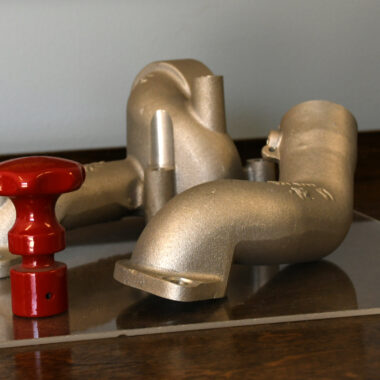Elevate Your Creations With Precision Aluminum Spreading Strategies
Precision aluminum spreading techniques supply a refined method to changing raw materials right into long lasting and elaborate productions. The precise procedure of light weight aluminum spreading unlocks a realm of opportunities for designers and developers looking for to boost their tasks to new heights.
Benefits of Precision Aluminum Spreading
Precision aluminum spreading uses a myriad of advantages in regards to item, effectiveness, and cost-effectiveness quality. Among the primary benefits of accuracy aluminum casting is the ability to produce intricate shapes with high dimensional precision. This process enables for detailed styles and accurate information to be duplicated consistently, making certain that the final items fulfill the needed specifications.

Additionally, the process of precision aluminum casting results in minimal material waste, making it a sustainable production alternative. By utilizing just the required quantity of aluminum needed for the casting, this method assists decrease total production prices and minimizes ecological influence.

Kinds Of Light Weight Aluminum Spreading Procedures
Having actually checked out the benefits of precision light weight aluminum casting, the emphasis currently moves towards understanding the different types of aluminum casting processes readily available in manufacturing sectors. Die spreading, one of the most typical approaches, involves infusing molten aluminum right into a steel mold and mildew at high stress.
One more prevalent method is sand casting, where a pattern of the desired part is pushed right into a sand mixture to produce a mold and mildew tooth cavity for pouring molten aluminum. Sand casting is affordable and appropriate for both tiny and massive manufacturing runs. Investment casting, on the various other hand, utilizes a wax pattern that is covered in ceramic and after that melted to leave a mold tooth cavity for aluminum spreading. This technique is favored for its ability to create dimensionally accurate and in-depth parts (aluminum casting illinois). Each of these aluminum spreading processes has its distinct benefits, dealing with various needs and specs in the manufacturing sector.

Devices and Tools Required
What important tools and tools are needed for successful aluminum casting processes in making industries? Precision aluminum casting methods require a certain collection of tools and tools to make certain exact and top quality results. By spending in the right tools and devices, manufacturers can attain efficient and precise light weight aluminum casting outcomes.
Design Considerations for Casting
Successful light weight aluminum spreading processes in making industries require careful factor to consider of design facets to ensure ideal outcomes. When creating for aluminum casting, one should pay interest to elements such as component geometry, wall surface density, draft angles, and fillets.
Moreover, including fillets to sharp edges helps in decreasing stress focus and improving the general structural stability of the cast part. Developers ought to likewise think about the location of parting lines and gating systems to ensure correct metal circulation and solidification. aluminum casting illinois. By very carefully addressing these style factors to consider, manufacturers can achieve top notch light weight aluminum castings that fulfill performance needs and improve the performance of the production procedure
Ending Up Techniques for Light Weight Aluminum Castings
Accuracy and careful ending up methods play a vital duty in improving the aesthetic appeal browse around here and useful performance of aluminum spreadings in numerous industrial applications. After the spreading process, aluminum components frequently require finishing to achieve the wanted surface quality and qualities. One usual ending up technique is machining, which entails removing excess material to accomplish specific dimensions and smooth surfaces. Machining can be made use of for detailed styles or tight resistances that are challenging to attain through casting alone.
Additionally, aluminum castings can undertake surface area therapies such as shot fining sand or blowing up to get rid of any kind of blemishes or harsh locations left from the casting process. These methods not just improve the aesthetic appearance of the spreading however also guarantee dimensional accuracy and surface area stability. Plating is one more popular finishing method that gives aluminum castings with boosted rust resistance, put on resistance, and aesthetic options with different shade options.
Conclusion
To conclude, precision aluminum casting uses numerous advantages for creating premium products. Understanding the various kinds of casting processes, required tools and devices, style factors to consider, and finishing methods is vital for attaining successful results. aluminum casting illinois. By carrying out these methods, suppliers can elevate their creations and generate intricate and precise light weight aluminum spreadings for numerous applications
Having actually discovered the advantages of accuracy aluminum spreading, the emphasis now changes in the direction of understanding the numerous kinds of light weight aluminum casting processes available in manufacturing industries. Financial investment casting, on the other hand, uses a wax pattern that is coated in ceramic and then thawed to leave a mold and mildew dental caries for light weight aluminum casting.Successful aluminum casting processes in making markets call for careful consideration of style facets to ensure ideal outcomes. By thoroughly dealing with these layout factors to consider, manufacturers can achieve top quality aluminum spreadings that meet performance demands and improve the efficiency of the production procedure.
Furthermore, light weight useful site aluminum spreadings can undertake surface area treatments such as shot fining sand or blowing up to get rid of any type of flaws or rough areas left from Full Report the spreading process.